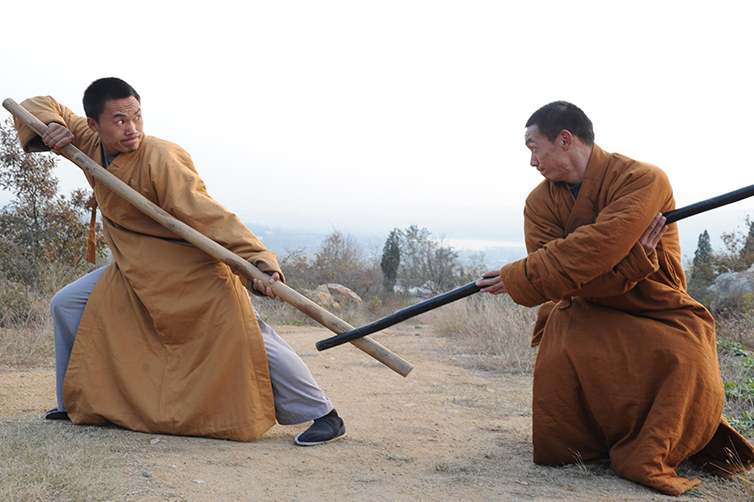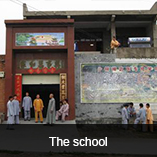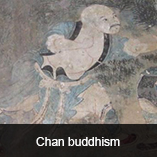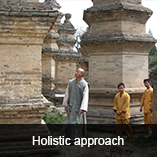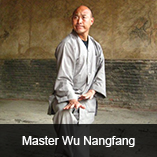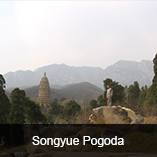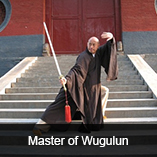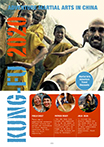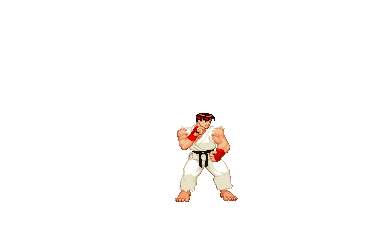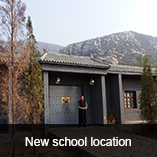 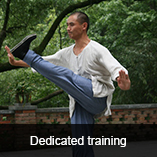 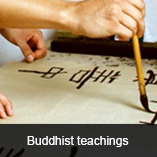 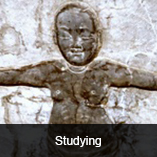 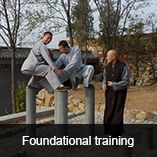  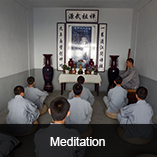 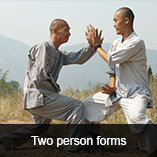  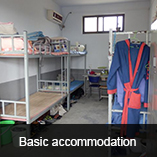 | | Training Chan Wu Yi (Buddhist Kungfu Medicine) is central to the Shaolin tradition and what you will learn at this school. Chan Qu Yi is a way of life in which the heart, body and chi are in total harmony with each other and with nature. The principles of Buddhism are adhered to but the practice is not Buddhist: it is a practice that has been developed for over a thousand years by monks at the Shaolin Temple in China.
The elements of Chan, Wu and Yi should always function as one ‘whole’— they cannot be divided into separate parts.
Chan is the training of the spiritual heart to be compassionate, calm, peaceful and aware in everyday life. The student should follow the path of the Buddha; have a caring heart; constantly watch his own faults; be happy in helping others; feel others’ pain as if it is his own; help them to confront their difficulties and to live happily; be constantly aware of love in the surrounding world.
Wu is the natural movement of the external body -- what we know as Kung Fu -- which is aimed at creating a healthy body and a strong chi. The understanding and mastering of Chan is the essential basis from which to practice these movements because, for the movements to be relaxed, flowing and natural, they must start from a compassionate, peaceful heart. So, for example, to try to practice Wu from the space of anger is dangerous both for the student and the people around him. The student should learn the ways to move naturally by constant practice until he masters them. This will take time.
Wu involves a number of theoretical concepts about the movements that the student initially has to be aware of but which, once mastered, become spontaneous and automatic.
The basic concept is SanJie -- 3 parts of the body. SanJie involves external movements which move simultaneously but have different functions: first, the upper section -- arms, hands and head – which starts the movement; second, the middle section-- waist and belly – which follows through on the previous movement; third, the lower, root, section -- hips, legs, knees and feet – which grounds the body.
The relationship between the three sections has its own unique function. For example, when a movement is performed from one of the three sections, the other two sections must be in harmony in order to generate the power from the movement performed. This means any movements must be supported by the power generated from the whole body.
Combining the power of the three sections is the basic step towards mastering the highest level of Kung Fu. It is therefore very important for practitioners to understand SanJie.
SiShao – reaching the four extremities – is another concept, a further step, in creating a greater power. When the power in the whole body is very strong these extremities have such power that, symbolically, in the case of the teeth -- the ends of bone -- something as hard as metal can be cut; in the case of the nails – the ends of the tendons – there can be a penetration to the bone; in the case of the hair – the end of the blood system – a hat could be lifted off the head; and in the case of the tongue -- the ends of the muscular system – the muscles are fully tensed and primed for whatever action is necessary.
To try to explain this in ‘layman’s’ terms one can consider the phenomenon of anger. When a person is extremely angry he is generating so much energy that he can destroy, maim, kill. His eyes bulge, his teeth are clenched, his lips are compressed, his muscles are bunched and he emits grunts or growls of anger which come from deep inside. He is full of power but has no awareness of what he is doing. The movements in wu simulate the energy and movements of anger, without the emotion and with total awareness of the power. The outward appearance of the harnessing of this internal energy shows in the characteristic compressed lips (so the chi does not escape), the bulging eyes, the particular body stance and the vocal grunts which happen as the chi arises from the dentian or hara. In this way the power of the chi is, in the case of the student, increased, or, in the case of the master, maintained or utilised. (In drawings, the great Master, Bodhidharma, is often depicted as angry or ferocious. He wasn’t. Simply the ancient artists understood the phenomenon of wu and so were depicting him in a typical Gong Fu pose of chi energy and power.)
When considering Yi, the five elements – metal (lung, nose), wood (liver, eyes), water (kidney, ears), fire (heart, tongue), earth (spleen, mouth) -- which are the basis of Chinese philosophy should be kept in mind. Yi is the practice of creating health and strength in the internal organs. Yi has two aspects: keeping oneself healthy and imparting this understanding to others so they can also be healthy In order to keep ourselves healthy we must know the relationships between the internal organs and the meridians through which vital energy – chi -- circulates and along which the acupuncture points are distributed. The importance of chi should be understood.
Chi includes two points: the innate chi energy found in the kidneys and the acquired energy that comes from ‘grains’ -- fresh food -- from the earth. Chi comes from the integration of these two sources. It takes constant intensive practice to develop and maintain the chi energy. Diet is all-important. The Shaolin style of vegetarian food has been developed over many years. The food should be light, not oily or greasy, and not strongly flavoured or spicy. This kind of diet reduces the inner heat of the body which allows the chi to flow more smoothly and efficiently. Aperture (Qiao) therapy is also important. The smooth flow of essential elements though the 9 apertures of the body keep the internal organs -- which play an essential role in the body’s metabolism -- healthy and strong. Using chantong herbal medicine improves the functioning of the 9 apertures. Another way to conserve one’s vital powers and maintain good health is by the practice of ‘internal’ Gong Fu. This is extremely difficult to explain but it involves working on the breath until breathing becomes as natural as that of a new-born baby – breathing deeply from the belly (the Chinese dentian or Japanese hara) rather than from the lungs and diaphragm. Few people breathe at anywhere near their full capacity; normal breathing is shallow and inadequate. With ‘right’ breathing the organs and nerves of the body are filled with oxygen and nutrients, thus reaching their potential power to function at an optimum, unknown level. The immune system is also strengthened. In addition, the person falls into a state of deep relaxation suffused with feelings of being deeply at ease and full of silent joy – a state of deep meditation.
Shaolin Wugulun Kung Fu should perfectly integrate all three parts: Chan, Wu and Yi. Here a mention should be made of XinYiBa which is the highest level and ultimate form of this kind of Shaolin Wugulun Kung Fu.
Important Training information
As a result of the depth of the training offered and the stages of development honed over thousands of years of both practice and knowledge. Students should if they want to get the best out of the training submit to it completely and adhere to Master Wu's personalised training plans. Below is a typical training schedule.
The training steps you will be taught:
1) Zhuang Gong: standing exercises to develop rooting, correct body posture and to build up Qi.
2) Pan Gen: basic exercises to learn how to move from one stance to another and to develop Shen Fa -- the way to create power from turning the body. 3) Movement and stepping exercises: to learn about spacing and distancing, timing, and anticipating your opponent’s movements.
4) Advanced training: very good for both health and fighting skills.
TYPICAL TRAINING SCHEDULE:
- 5.30-6.30 training (in summer this session will start at 4.30 am due to increasing temperatures. The training area is outside)
- 7.00-8.00 breakfast
- 8.30-11.30 training
- 12.00-2.30 lunch and rest
- 2.30-5.30 training
- 6.00-dinner
Students should be quietly in their rooms by 9.00 pm. |
